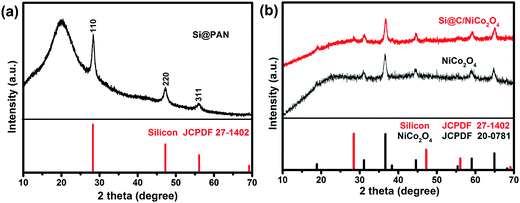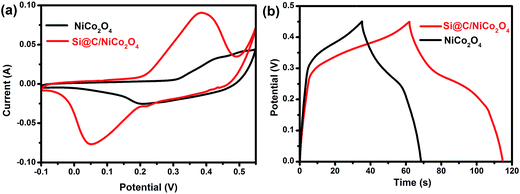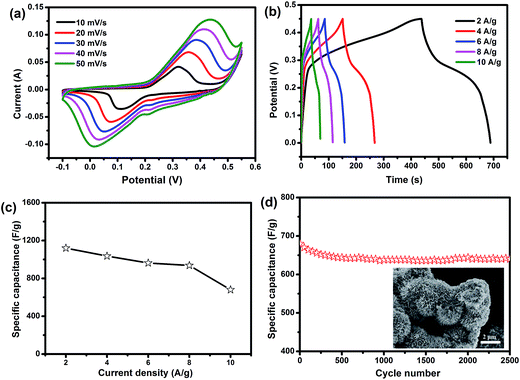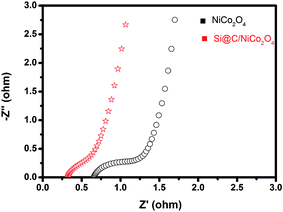Nanostructured Si@C/NiCo2O4 heterostructures for a high performance supercapacitor
Jing Guo,
Ziyang Dai,
Xiaoxian Zang,
Weili Si,
Wei Huang* and
Xiaochen Dong*
Key Laboratory of Flexible Electronics (KLOFE) & Institute of Advanced Materials (IAM), Jiangsu National Synergetic Innovation Center for Advanced Materials (SICAM), Nanjing Tech University (NanjingTech), 30 South Puzhu Road, Nanjing 211816, China. E-mail: iamxcdong@njtech.edu.cn; iamwhuang@njtech.edu.cn
First published on 29th January 2016
Abstract
As the second most abundant element on the earth, silicon exhibits excellent properties in many fields. Silicon hybrid transition metal oxides possess a low mass density and high specific capacity. To achieve the uniform dispersion of silicon in a composite, a nanostructured Si@C/NiCo2O4 heterostructure is fabricated via a facial hydrothermal method with silicon nanoslices encapsulated in polyacrylonitrile (PAN). The urchin-like Si@C/NiCo2O4 electrode exhibits excellent electrochemical properties, an efficient electron and ion transport pathway as well as the unique hybrid structure, which is useful to enhance the specific capacitance and present excellent cyclic stability (only 5.9% loss at 10 A g−1 after 2500 cycles). The outstanding electrochemical energy storage properties of the Si@C/NiCo2O4 heterostructures show great potential for the next generation high-performance supercapacitors.
Introduction
With the fast-growth of modern industry and the rapid expansion of population, the demand for a high performance power source has been increased. Supercapacitors have emerged as one of the most promising energy storage devices, and have attracted significant attention due to their long lifespan, high power density, rapid charge/discharge process and low cost.1–4 Based on the mechanisms of charge storage, supercapacitors could be classified into two groups, electric double layer capacitors (EDLCs) and pseudocapacitors. The EDLCs store energy via the directional arrangement on the surface of the solution interface by electrons. Pseudocapacitors save energy via the reversible faradaic redox reactions by the active materials in the electrode.5,6 The electrodes of EDLCs are usually composed of carbon materials, which have a large specific surface area, a long cycle life and excellent chemical corrosion resistance.7 On the contrary, pseudocapacitors offer much higher specific capacitance and higher energy density than that of EDLCs.8 To enhance the supercapacitor performance, one of the most important approaches is taking advantages of the superiority of both EDLCs and pseudocapacitors. Many studies have explored the use of hybrid materials as supercapacitor electrodes. The preparation involves relatively high cost and complicated methods, which prevents their production on large scale.Recently, some semiconductor materials have attracted more attention as the EDLC electrodes instead of traditional carbon materials, such as silicon carbide,9,10 titanium nitride,11,12 and titanium dioxide.13,14 Among the available semiconductor materials, silicon is the second most abundant element on the earth and exhibits excellent properties for various applications due to its low mass density and high specific properties. However, the conductivity and reactivity of surface-bound silicon atoms is suppressed by the surface traps of silicon. Furthermore, extreme reactivity of silicon with electrolyte limits its applicability in supercapacitors to some extent.15–17 These drawbacks have greatly prevented the application of silicon nanostructures on supercapacitor electrodes. To overcome these deficiencies, tremendous efforts have been made to find inexpensive alternative hybrid structures with excellent capacitive properties. For example, Landon Oakes has successfully grown a slim graphene blanket on the surface of silicon nanoparticles.18 The graphene coating not only blunts traps of surface charge but also provides a perfect environment of electrochemical interface between electrode and electrolyte. Ilgeun Oh has introduced MnO2 onto the surface of Si@C.19 In the hybrid structure, silicon can serve as a stable mechanical support, the carbon layer and metal oxide can promote reversible supercapacitance and decrease the diffusion path length to improve the electric capacitance of the composites.20–26 As known, ternary spinel nickel cobaltite (NiCo2O4), cost-effective, naturally abundant and with fast redox kinetics, possesses much better electrochemical performance than that of single component nickel or cobalt oxides.27–29 It is very challenging to synthesize uniform heterostructures of NiCo2O4, silicon nanoslices and carbon layer for supercapacitor electrodes.
In this study, the nanostructured Si@C/NiCo2O4 heterostructures are fabricated via a facile hydrothermal method with silicon nanoslices encapsulated in polyacrylonitrile (Si@PAN). This method not only facilitates uniform dispersion of silicon in Si@PAN, but also provides a carbon source for the formation of carbon based conductive layer. Importantly, when used as electrode materials for electrochemical capacitor, the Si@C/NiCo2O4 heterostructures present superior supercapacitor performance with excellent electrochemical properties.
Experimental section
Materials synthesis
All the chemicals and solvents used in the experiment were of analytical grade and employed without further purification. The silicon nanoslices were prepared by ball-milling method. Meanwhile, this method can be scaled up for mass production of nanosized Si materials at low cost. The silicon slices were well encapsulated in polyacrylonitrile (PAN) spheres by microsuspension polymerization and obtained Si@PAN. The urchin-like Si@C/NiCo2O4 heterostructures were synthesized with two steps: first by a hydrothermal method to get precursors and then the products were obtained by heating process. In a typical experiment, 0.24 g NiCl2·6H2O, 0.48 g CoCl2·6H2O and 15.0 mg polyvinyl pyrrolidone (PVP, Mw = 130![[thin space (1/6-em)]](https://www.rsc.org/images/entities/char_2009.gif) 000, K90-96) were dissolved in 30 ml deionized (DI) water with stirring until it becomes a homogeneous solution. Then, 1.25 g Si@PAN kept in DI water (wt = 15.1%) and 0.6 g urea were added into the as-obtained solution and sonicated for 10 min to form a well-dispersed suspension. The mixed solution was then transferred into a 50 ml Teflon cup. The autoclave was heated at 180 °C for 12 h. Finally, the precursors were harvested by several rinse-precipitation cycles. After annealing at 450 °C for 3 h in air, the Si@C/NiCo2O4 heterostructures were obtained. For comparison, the NiCo2O4 were prepared in the same method without adding Si@PAN spheres.
000, K90-96) were dissolved in 30 ml deionized (DI) water with stirring until it becomes a homogeneous solution. Then, 1.25 g Si@PAN kept in DI water (wt = 15.1%) and 0.6 g urea were added into the as-obtained solution and sonicated for 10 min to form a well-dispersed suspension. The mixed solution was then transferred into a 50 ml Teflon cup. The autoclave was heated at 180 °C for 12 h. Finally, the precursors were harvested by several rinse-precipitation cycles. After annealing at 450 °C for 3 h in air, the Si@C/NiCo2O4 heterostructures were obtained. For comparison, the NiCo2O4 were prepared in the same method without adding Si@PAN spheres.
Material characterization
The crystal structures of the synthesized samples were examined by X-ray diffraction (XRD, Bruker D8 Advance) with Cu-Kα radiation and energy dispersive spectroscopy (EDS) elemental mapping. The morphology and structure of the samples were investigated by field-emission scan electron microscopy (FESEM) and transmission electron microscopy (TEM). The surface area of the products were determined by Brunauer–Emmett–Teller (BET) nitrogen adsorption–desorption and Barrett–Joyner–Halenda (BJH) methods (Micromeritics, ASAP2020).Electrochemical measurements
All the electrochemical measurements were conducted using an electrochemical workstation (CHI 660E, CH instrument Inc, China) with 6 M KOH aqueous solution as electrolyte. In a conventional three-electrode system, active materials served as a working electrode, a saturated calomel electrode (SCE) as a reference electrode, and a Pt foil as a counter electrode. The working electrode was prepared by mixing the active materials, acetylene black and polyvinylidene fluoride (PVDF) binder with the weight ratio of 7![[thin space (1/6-em)]](https://www.rsc.org/images/entities/char_2009.gif) :
:![[thin space (1/6-em)]](https://www.rsc.org/images/entities/char_2009.gif) 2
2![[thin space (1/6-em)]](https://www.rsc.org/images/entities/char_2009.gif) :
:![[thin space (1/6-em)]](https://www.rsc.org/images/entities/char_2009.gif) 1. The mass loading of the active material was 1–2 mg cm−2. The specific capacitance can be calculated from the following equation:30
1. The mass loading of the active material was 1–2 mg cm−2. The specific capacitance can be calculated from the following equation:30| C = I × Δt/(m × ΔV) |
Results and discussion
The whole formation process of Si@C/NiCo2O4 heterostructures can be divided into two steps schematically illustrated in Fig. 1. First, the Si@PAN spheres, synthesized by microsuspension polymerization, react with Ni2+, Co2+ and OH− in Teflon-lined stainless steel autoclaves at high temperature to obtain precursors. On the one hand, the silicon slices encapsulated by the PAN can prevent its self-aggregation. On the other hand, the PAN can be transformed to N-doped carbon by carbonization during the heating treatment, which can improves the conductivity of the composites due to the existence of lone electron pairs of the nitrogen atoms.31 With the temperature increasing, a large amount of nanoneedles were generated, and assembled, and the urchin-like precursors were formed. Second, the precursors were converted into Si@C/NiCo2O4 heterostructures by thermal annealing at high temperature in air.Fig. 2 shows the X-ray diffraction (XRD) patterns of Si@PAN and Si@C/NiCo2O4, respectively. Fig. 2a shows three diffraction peaks at 28.4°, 47.3° and 56.1°, corresponding to the respective (111), (220), and (311) planes of silicon (JCPDS card no. 27-1402). At the same time, the relatively wide and weak diffraction peak appears at 24° confirm the existence of amorphous carbon.32 After the formation of Si@C/NiCo2O4, the well-defined diffraction peaks (Fig. 2b) can be successfully indexed and assigned to NiCo2O4 (JCPDS card no. 20-0781) and silicon (JCPDS card no. 27-1402), respectively.
Fig. 3a shows an over view of the morphology of the silicon nanoslices. It indicates that the silicon nanoslices present nanosheet structure and aggregate to form flower-like morphology with the size of around 800 nm. After wrapped by the PAN, the resulting Si@PAN shows sphere morphology with the diameter about 500 nm indicating that silicon nanoslices are dispersed uniformly and completely wrapped by the PAN (Fig. 3b). Fig. 3c shows the SEM image of Si@C/NiCo2O4, it can be observed that the heterostructures have a regular urchin-like morphology with the diameter of around 2 μm. Not only the diameter of the heterostructure is significantly different as compared to Si@PAN sphere, but the morphology is also completely dissimilar. It can be concluded that PAN spheres have been converted into viscous state at high temperature facilitating the release of silicon nanoslices which are completely and uniformly wrapped by NiCo2O4 later. The elemental mapping measurements (Fig. 3e–i) further indicate that the elements like nickel, cobalt, oxygen, silicon and carbon are uniformly dispersed in the heterostructures, which further confirms the formation of Si@C/NiCo2O4 heterostructures. The uniformly dispersed carbon layer also can enhance its conductivity and electrochemical performance greatly.
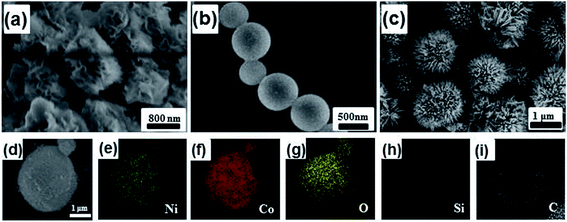 | ||
| Fig. 3 SEM images of (a) silicon slices, (b) Si@PAN spheres, (c–d) Si@C/NiCo2O4, and the EDX element mapping images of (e) nickel, (f) cobalt, (g) oxygen, (h) silicon, (i) carbon. | ||
Fig. 4a shows the TEM image of Si@PAN. Noticeably, it can be seen that PAN spheres have a smooth surface with uniform dispersion of silicon nanoslices, which further confirms that the silicon nanoslices are completely wrapped by the PAN. The TEM image of Si@C/NiCo2O4 (Fig. 4b) indicates that the heterostructure presents an urchin-like morphology, which is consistent with the SEM measurement. The HRTEM image shows that the inter-planar lattice spacings are about 0.28 and 0.24 nm, respectively, corresponding to the (220) and (311) lattice planes of the NiCo2O4 (Fig. 4c). The selected-area electron diffraction (SAED) pattern shown on Fig. 4d exhibits the diffraction rings from NiCo2O4 at (422), (220) and (222) planes, indicating the formation of NiCo2O4 heterostructure.
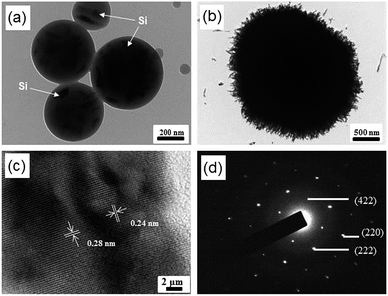 | ||
| Fig. 4 (a) TEM image of Si@PAN. (b and c) TEM and HRTEM images of Si@C/NiCo2O4. (d) SAED image of Si@C/NiCo2O4. | ||
Fig. 5a shows the cyclic voltammetry (CV) curves of NiCo2O4 and Si@C/NiCo2O4 at the scan rate of 30 mV s−1. Two obvious redox peaks can be found in the closed CV curves clearly. It should be related to the reversible reaction between of Co3+/Co4+ and Ni2+/Ni3+. The energy is stored thanks to electrolyte ions accumulation at the polarized electrode/electrolyte interface. Meanwhile, it reveals that the capacitance characteristics are mainly controlled by faradaic reaction. The faradic reaction can be described as follows:33–35
| NiCo2O4 + OH− + H2O ↔ NiOOH + 2CoOOH + e− | (1) |
| CoOOH + OH− ↔ CoO2 + H2O + e− | (2) |
The areas formed by CV curves reflect the performance of the supercapacitor electrode. As expected, the CV curve area of Si@C/NiCo2O4 heterostructure is much larger than that of NiCo2O4. This phenomenon can be related to three reasons: (a) silicon doped materials have excellent conductivity and cycling stability, which could exhibits an excellent electrochemical performance.36,37 (b) The conductivity of the heterostructure is greatly enhanced by the carbon layer. (c) The underlying synergistic effect between silicon, NiCo2O4 and carbon is conductive to ionic exchange in the electrode.
In order to further investigate the electrochemical performance of the two electrodes above, the galvanostatic charge–discharge (GCD) measurements are carried out at 8 A g−1. As shown in Fig. 5b, both the charge and discharge times of Si@C/NiCo2O4 heterostructure are much longer than those of NiCo2O4, which is in line with the CV results. According to the equation above, the specific capacitance of Si@C/NiCo2O4 heterostructures and NiCo2O4 are 936.7 and 592 F g−1, respectively at 8 A g−1. It further demonstrates that the electrochemical performance of Si@C/NiCo2O4 heterostructure is higher than that of NiCo2O4.
As shown in Fig. 6a, the CV curves of Si@C/NiCo2O4 heterostructure electrode at a scan rates of 10, 20, 30, 40, 50 mV s−1. A pair of strong redox peaks corresponding to the faradaic redox reactions can be obviously observed, which is caused by Ni and Co species and OH anions.38 With the increasing scan rate, the peak current increases clearly and the potential of anodic and redox peaks exhibits a limited shift towards the positive and negative potential, respectively. According to the literatures, this kind of hybrid electrode take advantage of both capacitor and battery components rather than a merely additive composite, which gives a significant improvements for the long lifespan, rapid charge/discharge process and low cost of electrochemical charge storage devices.39,40 It further confirms the pseudocapacitive behavior of the Si@C/NiCo2O4 heterostructure electrode. Meanwhile, the linear relationship between peak current and scan rate demonstrates a rapid redox reaction between the electrolyte and electrode controlled by the diffusion of OH−.41,42 Fig. 6b shows the GCD curves of the Si@C/NiCo2O4 heterostructure electrode conducted at different current densities. The voltage plateaus are located around 0.30 V, which suggests its excellent electrochemical reversibility and superior supercapacitance compared with the most of the NiCo2O4 electrodes reported in the literature.43,44 It can be calculated that the specific capacitances of the electrodes are 1120, 1036.4, 962.7, 936.7 and 680 F g−1 at 2, 4, 6, 8 and 10 A g−1, respectively. With the increase in current density, the specific capacitances of the Si@C/NiCo2O4 heterostructure electrodes decrease gently (Fig. 6c). This phenomenon comes from the fact that the ions cannot exchange adequately with the electric potential falling sharply. Fig. 6d shows the cycling performance of the Si@C/NiCo2O4 heterostructure electrode evaluated by a continuous charge–discharge testing at 10 A g−1. It can be found that around 94.1% of the initial specific capacitance is still maintained over 2500 cycles. And the SEM image of Si@C/NiCo2O4 after 2500 cycles also presents urchin-like morphology (inset of Fig. 6d), demonstrating excellent electrochemical stability of the electrode at high current density, which suggest that the carbon layer plays an important role compared with the similar structure.45 The enhance cycling stability can be attributed to two points: (a) urchin-like heterostructure possess high specific surface area which is advantageous for electrolyte permeation. (b) Carbon layer in the heterostructure enhances its conductivity and the silicon slice increases its electrochemical reversibility. Table 1 lists the comparison between Si@C/NiCo2O4 and other types of supercapacitor materials in literatures.
| Materials | Capacitance (F g−1) | Capacitance retention | Reference |
|---|---|---|---|
| NiCo2O4–GO | 870 (2 A g−1) | 69% (20 A g−1, 5000) | 1 |
| NiCo2O4/CNT | 828 (1 A g−1) | 99% (5 A g−1, 3000) | 2 |
| CQDs/NiCo2O4 | 856 (1 A g−1) | 98.75% (5 A g−1, 10![[thin space (1/6-em)]](https://www.rsc.org/images/entities/char_2009.gif) 000) 000) |
3 |
| Porous NiCo2O4 | 891 (1 A g−1) | 97.2% (2 A g−1, 8000) | 4 |
| Si@C/NiCo2O4 | 1120 (2 A g−1) | 94.1% (10 A g−1, 2500) | Our work |
The electrochemical impedance spectroscopy (EIS) analysis measurement is done to further investigate the insight of the electrochemical characteristics. Fig. 7 shows a typical Nyquist plot of the EIS tests recorded in the frequency range from 0.01 Hz to 100 kHz, which shows a semicircle in the high frequency region and a sloping straight line in the low frequency region. The axis intercept in high frequency range represents the internal resistance (Rs). Both the plot features a vertical curve in low-frequency regime, indicating a nearly capacitive behavior. It can also be seen that the high-frequency regimes present obvious transition from a vertical curve to an around 45° Warburg region followed by a semicircle. The diameters of the semicircles indicate that the charge transfer resistance of the Si@C/NiCo2O4 heterostructure electrode is ∼0.32 Ω, while the NiCo2O4 electrode is ∼0.67 Ω. It indicates that the Si@C/NiCo2O4 heterostructure electrode is more efficient for the electrolyte diffusion compared with NiCo2O4 electrode.
Conclusions
In conclusion, Si@C/NiCo2O4 heterostructure has been successfully synthesized in two steps with the Si@PAN spheres. In Si@PAN, silicon nanoslices are dispersed uniformly and the PAN provides a carbon source for the heterostructure simultaneously. The Si@C/NiCo2O4 heterostructure possesses superior supercapacitor performance and outstanding retention property. The improved electrochemical performance makes the Si@C/NiCo2O4 heterostructure a promising candidate for practical applications in electrochemical capacitors.Acknowledgements
The project was supported by Jiangsu Provincial Funds for Distinguished Young Scholars (BK20130046), Key University Science Research Project of Jiangsu Province (15KJA430006), the NNSF of China (21275076, 61525402), Program for New Century Excellent Talents in University (NCET-13-0853), QingLan Project, Synergetic Innovation Center for Organic Electronics and Information Displays, the Priority Academic Program Development of Jiangsu Higher Education Institutions (PAPD).References
- J. R. Miller and P. Simon, Science, 2008, 321, 651–652 CrossRef CAS PubMed.
- P. Simon and Y. Gogotsi, Nat. Mater., 2008, 7, 845–854 CrossRef CAS PubMed.
- R. Rakhi, W. Chen, D. Cha and H. Alshareef, Nano Lett., 2012, 12, 2559–2567 CrossRef CAS PubMed.
- C. C. Hu, W. C. Chen and K. H. Chang, J. Electrochem. Soc., 2004, 151, A281–A290 CrossRef CAS.
- G. Wang, X. Shen, J. Horvat, B. Wang, H. Liu, D. Wexler and J. Yao, J. Phys. Chem. C, 2009, 113, 4357–4361 CAS.
- M. Shao, F. Ning, Y. Zhao, J. Zhao, M. Wei, D. G. Evans and X. Duan, Chem. Mater., 2012, 24, 1192–1197 CrossRef CAS.
- N. Xiao, X. Dong, L. Song, D. Liu, Y. Tay, S. Wu, L.-J. Li, Y. Zhao, T. Yu and H. Zhang, ACS Nano, 2011, 5, 2749–2755 CrossRef CAS PubMed.
- C. Guan, X. Li, Z. Wang, X. Cao, C. Soci, H. Zhang and H. J. Fan, Adv. Mater., 2012, 24, 4186–4190 CrossRef CAS PubMed.
- Y. Korenblit, M. Rose, E. Kockrick, L. Borchardt, A. Kvit, S. Kaskel and G. Yushin, ACS Nano, 2010, 4, 1337–1344 CrossRef CAS PubMed.
- J. P. Alper, M. S. Kim, M. Vincent, B. Hsia, V. Radmilovic, C. Carraro and R. Maboudian, J. Power Sources, 2013, 230, 298–302 CrossRef CAS.
- Y. Xie and X. Fang, Electrochim. Acta, 2014, 120, 273–283 CrossRef CAS.
- C. Shang, S. Dong, S. Wang, D. Xiao, P. Han, X. Wang, L. Gu and G. Cui, ACS Nano, 2013, 7, 5430–5436 CrossRef CAS PubMed.
- X. Lu, M. Yu, G. Wang, T. Zhai, S. Xie, Y. Ling, Y. Tong and Y. Li, Adv. Mater., 2013, 25, 267–272 CrossRef PubMed.
- C. Xiang, M. Li, M. Zhi, A. Manivannan and N. Wu, J. Mater. Chem., 2012, 22, 19161–19167 RSC.
- V. Lehmann, F. Hofmann, F. Möller and U. Grüning, Thin Solid Films, 1995, 255, 20–22 CrossRef.
- J. C. Flake, M. M. Rieger, G. M. Schmid and P. A. Kohl, J. Electrochem. Soc., 1999, 146, 1960–1965 CrossRef CAS.
- T. Tsuda, T. Nohira, K. Amezawa, K. Hachiya, R. Hagiwara, O. Raz and Y. Ein-Eli, Electrochim. Acta, 2008, 53, 3650–3655 CrossRef.
- L. Oakes, A. Westover, J. W. Mares, S. Chatterjee, W. R. Erwin, R. Bardhan, S. M. Weiss and C. L. Pint, Sci. Rep., 2013, 3, 3020 Search PubMed.
- I. Oh, M. Kim and J. Kim, Chem. Eng. J., 2015, 273, 82–91 CrossRef CAS.
- F. Lu, M. Qiu, X. Qi, L. Yang, J. Yin, G. Hao, X. Feng, J. Li and J. Zhong, Appl. Phys. A: Mater. Sci. Process., 2011, 104, 545–550 CrossRef CAS.
- B. Tao, J. Zhang, F. Miao, S. Hui and L. Wan, Electrochim. Acta, 2010, 55, 5258–5262 CrossRef CAS.
- S. K. Ramasahayam, Z. Hicks and T. Viswanathan, ACS Sustainable Chem. Eng., 2015, 3, 2194–2202 CrossRef CAS.
- C. Shahana, C. Rachel, O. Landon, E. R. William, B. Rizia and L. P. Cary, J. Phys. Chem. C, 2014, 118, 10893–10902 Search PubMed.
- S. K. Ramasahayam, U. B. Nasini, A. U. Shaikh and T. Viswanathan, J. Power Sources, 2015, 275, 835–844 CrossRef CAS.
- M. P. Liu, C. H. Li, H. B. Du and X. Z. You, Chem. Commun., 2012, 48, 4950–4952 RSC.
- I. Oh, M. Kim and J. Kim, Appl. Surf. Sci., 2015, 328, 222–228 CrossRef CAS.
- H. Wang, Q. Gao and L. Jiang, Small, 2011, 7, 2454–2459 CAS.
- C. Yuan, J. Li, L. Hou, L. Yang, L. Shen and X. Zhang, J. Mater. Chem., 2012, 22, 16084–16090 RSC.
- Y. Zhang, M. Ma, J. Yang, H. Su, W. Huang and X. Dong, Nanoscale, 2014, 6, 4303–4308 RSC.
- X. C. Dong, H. Xu, X. W. Wang, Y. X. Huang, M. B. Chan-Park, H. Zhang, L.-H. Wang, W. Huang and P. Chen, ACS Nano, 2012, 6, 3206–3213 CrossRef CAS PubMed.
- Y. Zhang, C. Sun, H. Su, W. Huang and X. Dong, Nanoscale, 2015, 7, 3155–3163 RSC.
- W. Ruland and B. Smarsly, J. Appl. Crystallogr., 2002, 35, 624–633 CrossRef CAS.
- X. Liu, S. Shi, Q. Xiong, L. Li, Y. Zhang, H. Tang, C. Gu, X. Wang and J. Tu, ACS Appl. Mater. Interfaces, 2013, 5, 8790–8795 CAS.
- X. Y. Liu, Y. Q. Zhang, X. H. Xia, S. J. Shi, Y. Lu, X. L. Wang, C. D. Gu and J. P. Tu, J. Power Sources, 2013, 239, 157–163 CrossRef CAS.
- X. Wang, X. Han, M. Lim, N. Singh, C. L. Gan, M. Jan and P. S. Lee, J. Phys. Chem. C, 2012, 116, 12448–12454 CAS.
- B. Boukamp, G. Lesh and R. Huggins, J. Electrochem. Soc., 1981, 128, 725–729 CrossRef CAS.
- M. Winter, J. O. Besenhard, M. E. Spahr and P. Novak, Adv. Mater., 1998, 10, 725–763 CrossRef CAS.
- R. N. Singh, J. F. Koenig, G. Poillerat and P. Chartier, J. Electrochem. Soc., 1990, 137, 1408–1413 CrossRef CAS.
- V. Augustyn, J. Come, M. A. Lowe, J. M. Kim, P. L. Taberna, S. H. Tolbert, H. D. Abruña, P. Simon and B. Dunn, Nat. Mater., 2013, 12, 518–522 CrossRef CAS PubMed.
- C. Sun, M. Ma, J. Yang, Y. Zhang, P. Chen, W. Huang and X. C. Dong, Sci. Rep., 2014, 4, 7054 CrossRef CAS PubMed.
- X. Dong, Y. Cao, J. Wang, M. B. Chan-Park, L. Wang, W. Huang and P. Chen, RSC Adv., 2012, 2, 4364–4369 RSC.
- J. Liu, J. Jiang, M. Bosman and H. J. Fan, J. Mater. Chem. A, 2012, 22, 2419–2426 RSC.
- Q. Lu, Y. Chen, W. Li, J. G. Chen, J. Q. Xiao and F. Jiao, J. Mater. Chem. A, 2013, 1, 2331–2336 CAS.
- C. Yuan, J. Li, L. Hou, J. Lin, G. Pang, L. Zhang, L. Lian and X. Zhang, RSC Adv., 2013, 3, 18573–18578 RSC.
- M. Z. Ma, J. Guo, Y. F. Zhang, Z. Y. Dai, W. Huang and X. C. Dong, RSC Adv., 2015, 5, 62813–62818 RSC.
| This journal is © The Royal Society of Chemistry 2016 |


